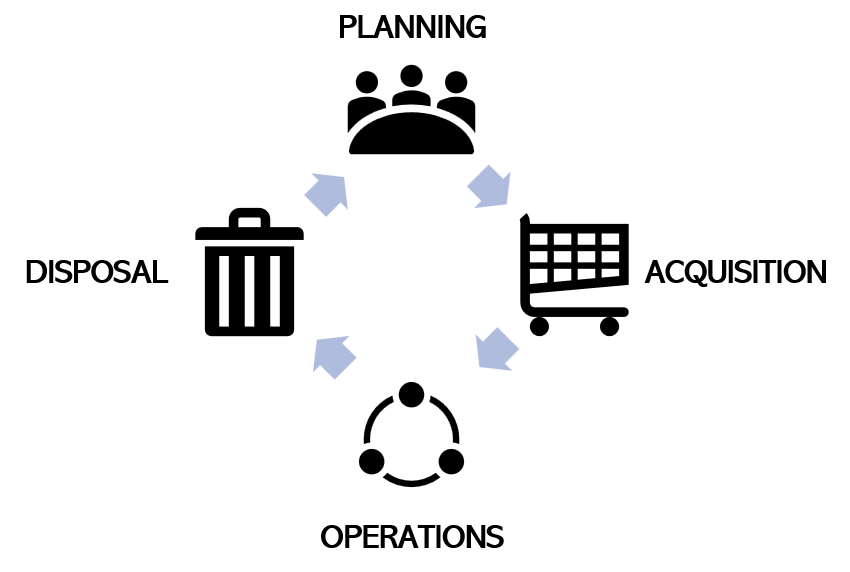Asset Lifecycle
What is it?
The IT Asset Lifecycle is a foundational concept in ITAM, encompassing the stages through which an asset passes from the point of inception to disposal. This article delineates the four critical phases of the asset lifecycle:

Planning
The journey of an IT asset begins long before its acquisition. The Planning phase is crucial to ensure that the assets acquired will align with the organizational objectives, and compliance requirements. During this stage, meticulous consideration is given to several factors including the budget, the specifications of the asset, future scalability, and the Total Cost of Ownership (TCO). Proper planning sets the stage for informed decision-making and procurement strategies which, in turn, align IT investments with organizational goals.
Planning: Good and Bad Habits
| Item | Good Practices | Bad Practices |
|---|---|---|
| Requirement Analysis | Conducting thorough analysis to understand exact needs and asset specifications. | Overlooking detailed requirement analysis leading to vague or incorrect asset specifications. |
| Compliance | Ensuring planned assets comply with legal, industry, and organizational standards. | Ignoring compliance requirements, risking legal and financial repercussions. |
| Stakeholder Engagement | Engaging all relevant stakeholders to gather inputs and ensure all perspectives are considered. | Excluding key stakeholders, causing lack of alignment between IT assets and organizational objectives. |
| Vendor Evaluation | Conducting comprehensive vendor evaluations to compare offerings, prices, and terms. | Rushing vendor selection without adequate evaluation, risking suboptimal asset acquisitions. |
| Future Scalability | Considering future growth and technological advancements to ensure asset relevance. | Neglecting scalability, resulting in assets becoming obsolete or inadequate. |
| TCO Analysis | Conducting Total Cost of Ownership analysis to understand long-term asset costs. | Overlooking TCO analysis, risking unforeseen long-term costs. |
| Risk Assessment | Conducting risk assessments to identify potential challenges and develop mitigation strategies. | Ignoring potential risks, leaving the organization unprepared for future challenges. |
Acquisition
The Acquisitions phase is where organizations procure the necessary assets identified during the planning phase. This stage involves vendor negotiations, purchase orders, licensing agreements, and warranty considerations. A well-structured acquisitions phase ensures that the organization obtains the right assets, at the right price, and at the right time. Effective procurement strategies can result in significant cost savings and lay a solid foundation for the efficient management of assets throughout their lifecycle.
Acquisition: Good and Bad Habits
| Item | Good Practices | Bad Practices |
|---|---|---|
| Purchase Timing | Purchasing assets during sales or using bulk discounts. | Impulsive buying without considering budget constraints. |
| Vendor Negotiation | Negotiating favorable terms with vendors for better pricing or support. | Failing to negotiate, missing opportunities for better terms. |
| Quality Assurance | Ensuring assets meet quality standards and performance expectations. | Overlooking quality checks, leading to subpar asset acquisitions. |
| Contract Review | Thoroughly reviewing contracts to ensure favorable terms and clear obligations. | Glossing over contract details, risking unfavorable terms. |
| Documentation | Maintaining detailed documentation of asset specifications, vendor agreements, and receipts. | Lack of proper documentation, leading to confusion and disputes. |
| Integration Planning | Planning for the integration of new assets with existing infrastructure. | Failing to plan for integration, causing disruptions and delays. |
Operations
Once acquired, assets transition to the Operations phase, where they are deployed, utilized, and maintained to ensure they serve the intended purpose efficiently. This phase is the longest and involves monitoring, maintenance, and optimization to ensure assets remain functional and continue to meet the organization’s needs. Effective operational management includes ensuring software compliance, timely upgrades, and routine maintenance, thereby mitigating risks and extending the useful life of the assets.
Operations: Good and Bad Habits
| Item | Good Practices | Bad Practices |
|---|---|---|
| Maintenance | Regular maintenance to ensure optimal performance and longevity. | Neglecting maintenance, leading to decreased asset lifespan and increased downtime. |
| Monitoring & Analytics | Utilizing monitoring tools to analyze asset performance and anticipate issues. | Failing to monitor assets, resulting in unanticipated breakdowns and performance issues. |
| Training & Support | Providing adequate training and support to users for effective asset utilization. | Lack of training, leading to improper use and decreased productivity. |
| License Compliance | Ensuring all software licenses are compliant with vendor agreements. | Ignoring license compliance, risking legal issues and financial penalties. |
| Cost Management | Monitoring and controlling operational costs to stay within budget. | Overlooking cost management, leading to budget overruns. |
| Security | Implementing robust security measures to protect assets from threats. | Neglecting security, risking data breaches and asset compromises. |
Disposal
The Disposal phase signifies the end of the asset's lifecycle. As assets become obsolete or are replaced, it's crucial to have a structured disposal process to mitigate legal risks and ensure data security. This phase may involve reselling, recycling, or disposing of assets in a manner compliant with environmental and legal requirements. A well-managed disposal phase ensures that the organization extracts the maximum value while adhering to compliance and ecological standards.
Disposal: Good and Bad Habits
| Item | Good Practices | Bad Practices |
|---|---|---|
| Data Wiping | Thoroughly wiping data to prevent sensitive information leakage. | Failing to properly erase data, risking security breaches. |
| Environmentally Friendly Disposal | Adhering to eco-friendly disposal methods like recycling or donating. | Disposing of assets irresponsibly, harming the environment. |
| Asset Valuation | Assessing the residual value of assets for resale or write-off purposes. | Ignoring asset valuation, leading to financial inaccuracies. |
| Documentation | Maintaining detailed records of asset disposal for compliance and auditing. | Lack of proper documentation, risking legal and compliance issues. |
| Compliance with Laws and Regulations | Ensuring disposal practices comply with relevant laws and regulations. | Neglecting legal and regulatory compliance, risking penalties. |
| Stakeholder Communication | Communicating disposal plans with stakeholders to ensure a smooth process. | Failing to inform stakeholders, leading to confusion and potential disruptions. |
Summary
A structured and well-thought-out approach to IT Asset Lifecycle Management is essential for organizations looking to optimize their IT investments. By meticulously navigating through the Planning, Acquisitions, Operations, and Disposal phases, organizations can achieve a balance between operational efficiency, cost management, and compliance adherence.



